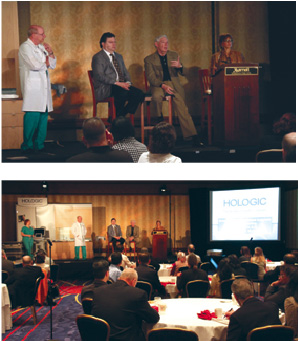HOME
.................................................
Manage the Axilla with Z11 Data
.................................................
Meeting Highlights
.................................................
ASBS Summary
.................................................
Next Generation MammoSite Multi-Lumen
.................................................
Accelerated Partial Breast Irradiation Tech Bulletin
.................................................
Literature Corner
................................................
Editors' Bios

Pamela Benitez, MD
Dr. Benitez is a general surgeon
focusing exclusively on diseases
of the breast and breast cancer
at William Beaumont Hospital in
Royal Oak, Michigan
Martin Keisch, MD
Dr. Keisch is a board-certified radiation oncologist at University of Miami Hospital and President of Cancer HealthCare Associates (CHCA)
|
 |
| ASBS: Treatment Affects
Risk of DCIS Recurrence |
A study found that women diagnosed with DCIS who were treated with radiation therapy after lumpectomy to surgically excise the DCIS were less likely to have cancer recur in the same breast compared to women who didn't have radiation therapy after surgery.
Excision plus radiotherapy was associated with a 10-year recurrence rate of 18% compared with 30% for surgery alone (P=0.01). However, more than half of the recurrences were invasive compared to 38% in women who had only excision (P=0.0459). Recurrence after excision and radiotherapy occurred later and more often arose in a different breast quadrant.
Grumley JW et al. "Difference in recurrence patterns by treatment in patients with DCIS" ASBS 2011; Abstract 1642.
|
| ASBS: Prophylactic Mastectomy Good Even Years Later |
Investigators surveyed patients who had contralateral prophylactic mastectomy at the Mayo Clinic from 1960 to 1993. All of the women had unilateral breast cancer and a positive family history.
An initial survey conducted was an average of 10 years after prophylactic mastectomy attracted responses from 583 women (J Clin Oncol 2005; 23: 7849-7856). A second survey was sent to the patients an average of 20 years after prophylactic mastectomy, and 269 of 503 still alive responded to the questionnaire. Responses to the first survey showed that 86% of women were still satisfied with contralateral prophylactic mastectomy 10 years after the surgery, including 46% who were very satisfied and 40% who were somewhat satisfied. About 8% expressed neither satisfaction nor dissatisfaction, 5% were somewhat dissatisfied, and 1.2% were very dissatisfied.
At the 20-year mark, 90% of the women remained satisfied with the procedure, split almost evenly between very satisfied and somewhat satisfied. The proportion of patients with no opinion declined to 3.5% and the proportion who were somewhat dissatisfied to 4%. Boughey reported that 2% of women were very dissatisfied, an increase of 0.8%.
Boughey JC, et al "Contralateral prophylactic mastectomy: Consistency of satisfaction and psychosocial consequences over time" ASBS 2011; Abstract 1693.
|
| ASBS: Mammogram Studies Suggest Use in Younger Women |
Results from two studies presented at the 2011 Annual Meeting of the American Society of Breast Surgeons strongly support the value of regular mammogram screenings starting at age 40.
The first study found that breast cancers diagnosed in women between the ages of 40 and 49 were at a more advanced stage when they were found by something other than a mammogram (a breast self-exam, for example) compared to cancers found by mammogram.
The second study found that very early-stage breast cancer (DCIS or stage I) diagnosed in women between the ages of 40 and 49 is more likely to be an aggressive type — HER2-positive or triple-negative — compared to women 50 and older who were diagnosed with breast cancer.
Dale, P, et al "Mammography in 40 Year Old Women: The Potential Impact of the U.S. Preventative Services Task Force (USPSTF) Mammography Guidelines" ASBS; Abstract 1754.
|
| ASBS 2011 Breakfast Symposium:
A day in the Surgeon's Office |
| This past April at the 12th Annual American Society of Breast Surgeons Meeting in Washington, DC — Drs. Pamela Benitez, Peter Blumencranz, Mark Gittleman and Richard Fine, along with Beth Boyd, RN, presented to a full house of surgeons! More than 80 people attended the breakfast symposium entitled "A Day in the Breast Surgeon's Office." Dr. Benitez narrated as Dr Blumencranz and Beth Boyd took the audience through a typical office day performing a diagnostic ultrasound, in-office biopsy utilizing the Celero (breast biopsy device), a MammoSite Cavity Evaluation Device (CED) swap and a new patient treatment consult. Drs. Gittleman and Fine provided a play by play commentary and presented to the audience the possible reimbursement/coding for each in-office clinical scenario. Attendees walked away with a very good impression of how Hologic products can help make their office days easier, more efficient and better for patients. |
 |
|

